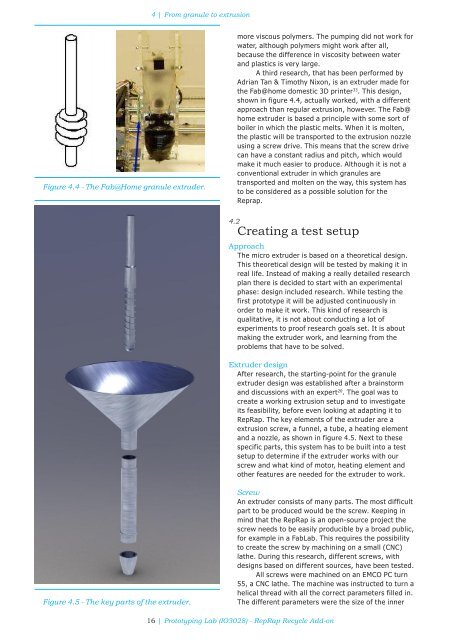reprap-granule-extruder-tudelft1
reprap-granule-extruder-tudelft1
reprap-granule-extruder-tudelft1
Create successful ePaper yourself
Turn your PDF publications into a flip-book with our unique Google optimized e-Paper software.
4 | From <strong>granule</strong> to extrusion<br />
Figure 4.4 - The Fab@Home <strong>granule</strong> <strong>extruder</strong>.<br />
more viscous polymers. The pumping did not work for<br />
water, although polymers might work after all,<br />
because the difference in viscosity between water<br />
and plastics is very large.<br />
A third research, that has been performed by<br />
Adrian Tan & Timothy Nixon, is an <strong>extruder</strong> made for<br />
the Fab@home domestic 3D printer 33 . This design,<br />
shown in figure 4.4, actually worked, with a different<br />
approach than regular extrusion, however. The Fab@<br />
home <strong>extruder</strong> is based a principle with some sort of<br />
boiler in which the plastic melts. When it is molten,<br />
the plastic will be transported to the extrusion nozzle<br />
using a screw drive. This means that the screw drive<br />
can have a constant radius and pitch, which would<br />
make it much easier to produce. Although it is not a<br />
conventional <strong>extruder</strong> in which <strong>granule</strong>s are<br />
transported and molten on the way, this system has<br />
to be considered as a possible solution for the<br />
Reprap.<br />
4.2<br />
Creating a test setup<br />
Approach<br />
The micro <strong>extruder</strong> is based on a theoretical design.<br />
This theoretical design will be tested by making it in<br />
real life. Instead of making a really detailed research<br />
plan there is decided to start with an experimental<br />
phase: design included research. While testing the<br />
first prototype it will be adjusted continuously in<br />
order to make it work. This kind of research is<br />
qualitative, it is not about conducting a lot of<br />
experiments to proof research goals set. It is about<br />
making the <strong>extruder</strong> work, and learning from the<br />
problems that have to be solved.<br />
Extruder design<br />
After research, the starting-point for the <strong>granule</strong><br />
<strong>extruder</strong> design was established after a brainstorm<br />
and discussions with an expert 20 . The goal was to<br />
create a working extrusion setup and to investigate<br />
its feasibility, before even looking at adapting it to<br />
RepRap. The key elements of the <strong>extruder</strong> are a<br />
extrusion screw, a funnel, a tube, a heating element<br />
and a nozzle, as shown in figure 4.5. Next to these<br />
specific parts, this system has to be built into a test<br />
setup to determine if the <strong>extruder</strong> works with our<br />
screw and what kind of motor, heating element and<br />
other features are needed for the <strong>extruder</strong> to work.<br />
Figure 4.5 - The key parts of the <strong>extruder</strong>.<br />
Screw<br />
An <strong>extruder</strong> consists of many parts. The most difficult<br />
part to be produced would be the screw. Keeping in<br />
mind that the RepRap is an open-source project the<br />
screw needs to be easily producible by a broad public,<br />
for example in a FabLab. This requires the possibility<br />
to create the screw by machining on a small (CNC)<br />
lathe. During this research, different screws, with<br />
designs based on different sources, have been tested.<br />
All screws were machined on an EMCO PC turn<br />
55, a CNC lathe. The machine was instructed to turn a<br />
helical thread with all the correct parameters filled in.<br />
The different parameters were the size of the inner<br />
16 | Prototyping Lab (IO3028) - RepRap Recycle Add-on


